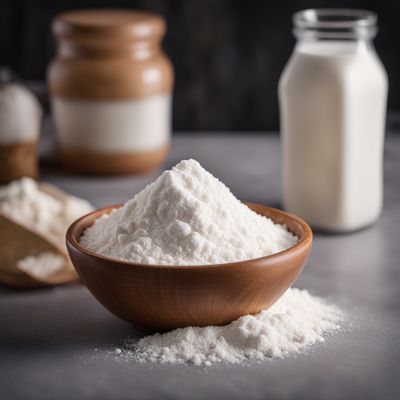
Ingredient
Milk powder, skimmed
The Versatile Dairy Essential
Skimmed milk powder is a fine, off-white powder with a slightly sweet and creamy taste. It dissolves easily in liquid and can be reconstituted to create liquid milk. With a smooth texture, it adds richness and creaminess to various recipes. Skimmed milk powder is a popular choice for those seeking a low-fat dairy option without compromising on taste or nutritional value.
Origins and history
Skimmed milk powder has been used for centuries as a way to preserve milk and extend its shelf life. It was first developed in the late 19th century as a solution to the transportation and storage challenges of fresh milk. Today, it is produced by evaporating the water content from skimmed milk, resulting in a concentrated powder that retains the essential nutrients found in milk. Skimmed milk powder is widely consumed around the world and plays a crucial role in the food industry, particularly in baking, confectionery, and dairy-based products.
Nutritional information
Skimmed milk powder is a rich source of protein, calcium, and essential vitamins such as vitamin D and vitamin B12. It is also low in fat and cholesterol, making it a suitable option for individuals looking to reduce their fat intake while still obtaining the nutritional benefits of dairy. A 1/4 cup (23g) serving of skimmed milk powder provides approximately 80 calories, 8 grams of protein, and 10% of the recommended daily intake of calcium.
Allergens
Contains milk and lactose.
How to select
When selecting skimmed milk powder, look for a reputable brand that follows proper manufacturing and storage practices. Check the packaging for any signs of damage or tampering. Opt for a product that has a long shelf life and is stored in a cool, dry place. Additionally, consider purchasing from a trusted source to ensure the quality and authenticity of the product.
Storage recommendations
To maintain the freshness and quality of skimmed milk powder, store it in an airtight container in a cool, dry place away from direct sunlight. Avoid exposure to moisture, as it can cause the powder to clump. Proper storage will help extend its shelf life and prevent the development of off-flavors or odors.
How to produce
Skimmed milk powder can be produced by removing the fat content from fresh milk through a process called centrifugation or by evaporating the water content from skimmed milk. However, producing skimmed milk powder at home is not practical for most individuals, as it requires specialized equipment and knowledge of the drying process. It is best to purchase skimmed milk powder from a reputable supplier.
Preparation tips
Skimmed milk powder can be reconstituted with water to create liquid milk for drinking, cooking, or baking purposes. It is commonly used in recipes such as bread, cakes, cookies, and sauces to enhance their flavor and texture. When using skimmed milk powder in baking, it is important to adjust the liquid content of the recipe accordingly. Additionally, skimmed milk powder can be added to smoothies, shakes, or hot beverages for a boost of protein and nutrients.
Substitutions
Whole milk powder, soy milk powder
Culinary uses
Skimmed milk powder is commonly used in a wide range of culinary applications, including baking, cooking, and as a base for sauces, soups, and desserts. It adds richness, creaminess, and nutritional value to various dishes. Skimmed milk powder is often incorporated into bread, cakes, cookies, and pastries to improve their texture and flavor. It is also used in the production of chocolates, ice creams, and yogurts to enhance their creaminess and extend their shelf life.
Availability
Skimmed milk powder is widely available in grocery stores, supermarkets, and online retailers worldwide. It is commonly found in the baking aisle or the dairy section of the store. Additionally, it is often sold in bulk quantities for commercial use in the food industry.

